Introduction:
Diaphragm walls are essential engineering structures used in various construction projects worldwide. They offer unique advantages but also come with their set of challenges and limitations. In this comprehensive guide, we will delve into the diaphragm walls advantages and disadvantages, exploring their applications, construction process, and considerations for optimal use.
Advantages of Diaphragm Walls:
- Superior Structural Support: Diaphragm walls provide exceptional structural support, particularly in deep excavations and high-rise buildings. Their robust construction resists lateral pressures, making them ideal for stabilizing soil and preventing ground movement.
- Water Tightness: One of the significant advantages of diaphragm walls is their ability to create watertight barriers. By utilizing appropriate construction techniques and materials, such as bentonite slurry, diaphragm walls effectively prevent water infiltration, making them invaluable in projects involving below-ground structures or waterfront developments.
- Minimal Footprint: Compared to other retaining wall systems, diaphragm walls have a relatively small footprint. This makes them suitable for urban environments or sites with limited space, where traditional methods like sheet piling may not be feasible.
- Versatility: Diaphragm walls offer versatility in design and construction, accommodating various ground conditions and structural requirements. They can be constructed to considerable depths and adapted to different shapes and configurations, providing flexibility for engineers and architects in their project designs.
- Durability: Constructed using reinforced concrete or steel, diaphragm walls boast impressive durability. Once installed, they require minimal maintenance and have a long service life, ensuring the longevity of the structures they support.
Disadvantages of Diaphragm Walls:
- High Initial Cost: One of the primary drawbacks of diaphragm walls is their relatively high initial cost compared to other retaining wall systems. The complex construction process involving specialized equipment and skilled labor contributes to higher upfront expenses, which may deter some project owners.
- Construction Time: Building diaphragm walls is a time-consuming process, particularly in deep excavations or challenging soil conditions. The need for meticulous excavation, installation of reinforcement, and casting of concrete panels can extend project timelines, impacting overall project schedules.
- Limited Accessibility: Access limitations can pose challenges during the construction of diaphragm walls, especially in congested urban areas or sites with restricted entry points. Maneuvering heavy machinery and transporting materials to the excavation site may require careful planning and coordination, adding complexity to the construction process.
- Environmental Impact: The construction of diaphragm walls can have environmental implications, primarily related to noise, vibration, and disruption to surrounding areas. Measures to mitigate these impacts, such as noise barriers and vibration monitoring, need to be implemented to minimize disturbances to nearby residents and ecosystems.
- Maintenance Considerations: While diaphragm walls are durable structures, periodic inspections and maintenance are necessary to ensure their integrity over time. Factors such as corrosion of steel reinforcement, degradation of sealing materials, and ground movement may require remedial action to prevent potential issues and maintain the functionality of the walls.
Conclusion:
Diaphragm walls offer a host of advantages in terms of structural support, water tightness, versatility, and durability, making them indispensable in many construction projects. However, it’s essential to consider the associated disadvantages, including high initial costs, construction time, limited accessibility, environmental impact, and maintenance requirements. By weighing these factors and implementing appropriate design and construction strategies, engineers and project stakeholders can harness the full potential of diaphragm walls while mitigating potential challenges.
Hindustan Diaphragm wall, a leader in modern construction practices, has revolutionized the industry with its unparalleled strength, versatility, and durability. From towering skyscrapers to intricate underground tunnels, diaphragm walls have become indispensable elements in shaping the urban landscape. Hindustan D-wall’s innovative solutions provide robust foundation support, enabling the construction of tall buildings and large structures with confidence.
Additionally, their expertise in creating efficient space utilization through underground parking facilities and basements helps address the growing demand for urban infrastructure. Moreover, Hindustan D-wall’s commitment to reliable waterproofing ensures the longevity and integrity of structures in challenging environments. With their cutting-edge technology and commitment to excellence, Hindustan D-wall continues to drive progress and innovation in the construction industry, shaping the cities of tomorrow.







